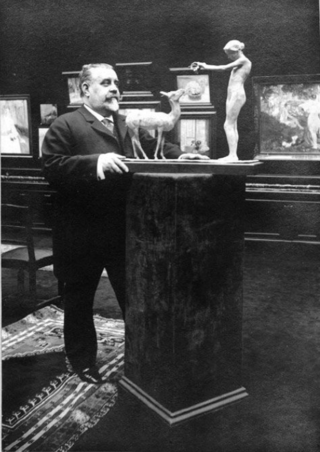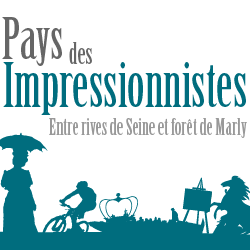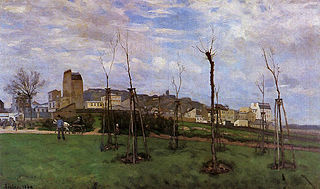
Pierre-Auguste Renoir was a French artist who was a leading painter in the development of the Impressionist style. As a celebrator of beauty and especially feminine sensuality, it has been said that "Renoir is the final representative of a tradition which runs directly from Rubens to Watteau."

Alfred Sisley was an Impressionist landscape painter who was born and spent most of his life in France, but retained British citizenship. He was the most consistent of the Impressionists in his dedication to painting landscape en plein air. He deviated into figure painting only rarely and, unlike Renoir and Pissarro, he found that Impressionism fulfilled his artistic needs.

Georges Petit was a French art dealer, a key figure in the Paris art world and an important promoter and cultivator of Impressionist artists.

The Terrace at Saint-Germain, Spring is a painting by English Impressionist painter Alfred Sisley, completed in 1875. It is in The Walters Art Museum collection.

The Pays des Impressionnistes is a certification mark created by the Syndicat intercommunal à vocations multiples des Coteaux de Seine in 2001 to promote the cultural heritage of this touristic area. Nine municipalities in the Yvelines department of France bordering the loop of the Seine River, where, during the nineteenth century, impressionist painters exercised their art, are associated with this creation: Bougival, Carrières-sur-Seine, Chatou, Croissy-sur-Seine, Le Pecq, Le Port-Marly, Louveciennes, Marly-le-Roi and Noisy-le-Roi. There is the Path of the Impressionists, four hiking trails dotted with reproductions of paintings, reflecting the still remarkable character of this landscape of Impressionist sites which has been proposed for inclusion in the World Heritage Site since 2009. Rueil-Malmaison, in the Hauts-de-Seine department, joined them in 2010, when eight of these municipalities have entrusted development task of the Pays des Impressionnistes to the visitor center of Marly-le-Roi, which organises Impressionist cruises along the banks of the Seine, as well as visits of ateliers of contemporary painters.

La Parisienne is an oil painting by the French artist Pierre-Auguste Renoir, completed in 1874 and now displayed at the National Museum Cardiff. The work, which was one of seven presented by Renoir at the First Impressionist Exhibition in 1874, is often referred to as The Blue Lady(French: La Dame en Bleu) and is one of the centre-pieces of the National Museum's art collection.
Victor Alfred Paul Vignon was a French Impressionist landscape painter and graphic artist. He was involved with the impressionism movement and its protagonists, as he exhibited at the fifth, sixth, seventh, and eight Paris Impressionist Exhibitions from 1880 to 1886.

Skaters in the Bois de Boulogne is an oil-on-canvas landscape painting by the French artist Pierre-Auguste Renoir, created during the winter of 1868. The painting depicts a snowscape with many Parisians, young and old, spending leisure time on a frozen park lake. Due to Renoir's strong dislike of cold temperatures and snow, the piece is one of his few winter landscapes.

La Promenade is an oil on canvas, early Impressionist painting by the French artist Pierre-Auguste Renoir, created in 1870. The work depicts a young couple on an excursion outside of the city, walking on a path through a woodland. Influenced by the rococo revival style during the Second Empire, Renoir's La Promenade reflects the older style and themes of eighteenth-century artists like Jean-Honoré Fragonard and Jean-Antoine Watteau. The work also shows the influence of Claude Monet on Renoir's new approach to painting.

Lise with a Parasol is an oil on canvas painting by French artist Pierre-Auguste Renoir, created in 1867 during his early Salon period. The full-length painting depicts model Lise Tréhot posing in a forest. She wears a white muslin dress and holds a black lace parasol to shade her from the sunlight, which filters down through the leaves, contrasting her face in the shadow and her body in the light, highlighting her dress rather than her face. After having several paintings rejected by the Salon, Renoir's Lise with a Parasol was finally accepted and exhibited in May 1868.

Bazille's Studio is an oil-on-canvas painting created in 1870 by the French Impressionist Frédéric Bazille. The painting is also known as L'Atelier de la rue Condamine, The Studio, and The Studio on the Rue La Condamine. It has been in the collection of the Musée d'Orsay in Paris since 1986. It shows the artist himself surrounded by his friends and paintings in his studio, capturing the artistic and social conditions of Paris in 1870.

The Seine at Port-Marly, Piles of Sand is an 1875 painting by Alfred Sisley. It was exhibited at the Exposition Universelle in 1900 whilst in the collection of Dr. Georges Viau, a Paris dentist and art collector. By 4 March 1907 it was owned by Durand-Ruel, who tried and failed to auction it on 4 March that year. It was bought by the galerie Bernheim-Jeune in April 1920 and later by Martin A. Ryerson. In 1933 Ryerson left it to its present owner, the Art Institute of Chicago, where it is now in section 201 (Impressionists) on the 1st floor of the Art Institute of Chicago.

The Watering Trough at Marly with Hoarfrost is an 1876 painting by Alfred Sisley. It was owned by François Depeaux, a Sisley collector, and passed through other collections before ending up in that of Paul Mellon. It is now in the Virginia Museum of Fine Arts in Richmond, United States. It was painted at Marly-le-Roi and is part of his Marly series. Sisley's works showing the watering trough and The Flood at Port-Marly are two series of Impressionist masterworks comparable to Claude Monet's Gare Lazare series, Renoir's The Swing and Bal du moulin de la Galette series, Berthe Morisot's Champs de blé series and Camille Pissarro's Vues de Pontoise and Toits rouges series. Sisley did not much change his point of view between each painting, but he dramatically changed the background, proving his ability to vary views of a limited section of countryside.

The Aqueduct at Marly or The Aqueduct at Louveciennes is an 1874 painting by Alfred Sisley. It was bought from the artist by Paul Durand-Ruel in 1876 before being acquired by Edward Libbey, who in turn donated it to the Toledo Museum of Art, where it now hangs. It shows the Aqueduc de Louveciennes. A lifesize reproduction of it is sited at the site of its creation as part of the Pays des Impressionnistes scheme.

The Church at Noisy-le-Roi, Autumn Effect or The Bell-Tower at Noisy-le-Roi, Autumn Effect is an Impressionist painting by Alfred Sisley.

Place du Chenil in Marly, Snow Effect is an 1876 oil on canvas painting by Alfred Sisley. It is now in the Musée des beaux-arts de Rouen, to which it was given by François Depeaux in 1909 It was painted at Marly-le-Roi and a lifesize reproduction of it is on display near the site of its creation as part of the Pays des Impressionnistes trail.

View of Montmartre from Cité des Fleurs to Les Batignolles is an oil-on-canvas painting by Alfred Sisley, produced in spring 1869 and now in the Musée de Grenoble. It bears national museums reference France Inv. MG 1317. It was given to that museum in 1901 by the artist's friend and fellow painter Joseph-Auguste Rousselin, only two years after Sisley's death. It is one of the first Impressionist paintings to depict Montmartre, showing it as in very verdant surrounds.

Frost in Louveciennes is an 1873 painting by Alfred Sisley, which has been in the Pushkin Museum since 1948. It shows the church of St Martin in the French town of Louveciennes. A chalk sketch for it is now in the Budapest Museum of Fine Arts . The work's early provenance is unknown until on 3 May 1902 Paul Durand-Ruel bought it for 9300 francs at the sale of Jules Strauss's collection at the Hotel Drout auction house. In 1903 Durand-Ruel sold it on to Ivan Morozov - it was one of his first acquisitions. The Pushkin Museum holds a 22 June 1903 letter from Durand-Ruel to Morozov agreeing to sell the work for 11,500 francs, despite this being a big sacrifice for his gallery, and a 27 June receipt for receiving the money.

View of Auvers-sur-Oise is the common English name for a Paul Cézanne painting known by various French names, usually Paysage d'Auvers-sur-Oise, or in the artist's catalogue raisonné, Groupe de maisons, paysage d'île de France. It is believed to have been painted in 1879–80, several years after Cézanne's residence in Auvers-sur-Oise, a small village northwest of Paris. The painting depicts a landscape of Northern France; the exact location has not been determined.

Madame Georges Charpentier and Her Children is an 1878 oil on canvas painting by Pierre-Auguste Renoir. It depicts Marguerite Charpentier, a French salonist, art collector, and advocate of the Impressionists, and her children Georgette and Paul. The painting is held by the Metropolitan Museum of Art.



















